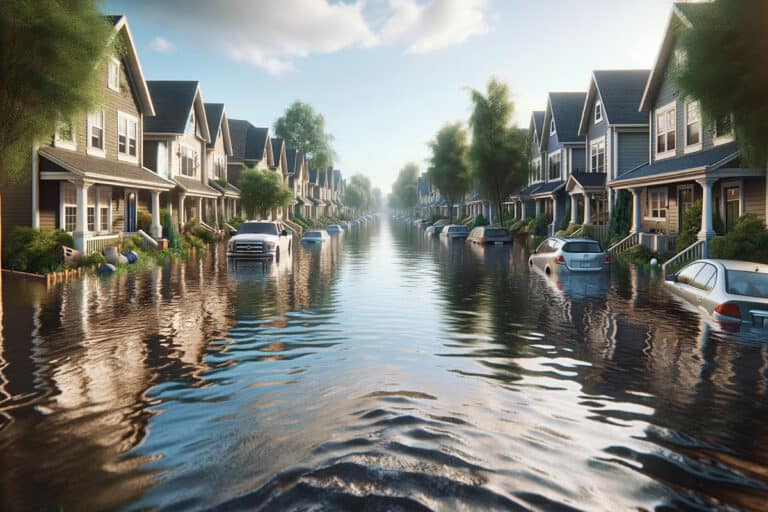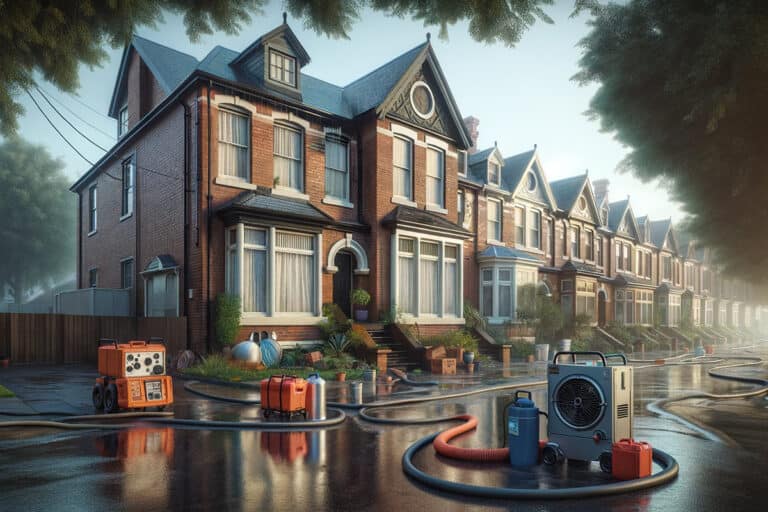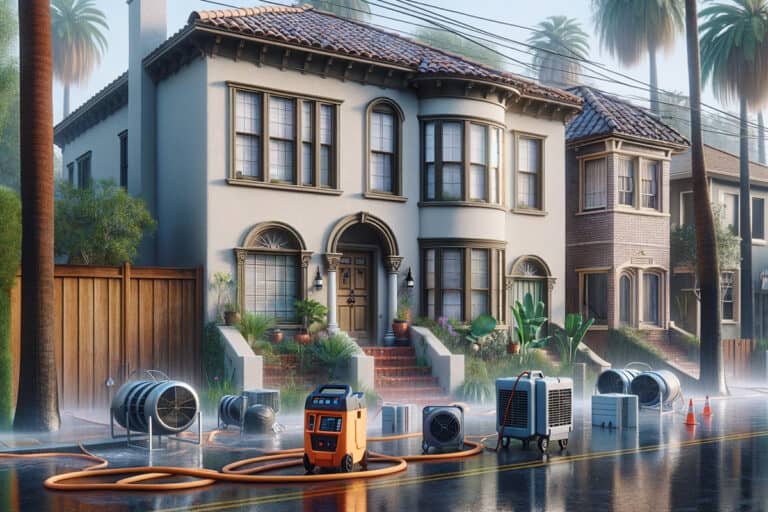Disclosure: I am compensated for purchases made through some links on this site. Click for details.
When disaster strikes in the form of water damage, it’s not just your immediate surroundings that are affected. The repercussions ripple through the very foundation of your home and can linger in the health of those who inhabit it. Water damage, resulting from floods, leaks, or burst pipes, can lead to structural weakening, mold growth, and a host of other issues that threaten both your sanctuary and your safety.
Recognizing the urgency of mitigation cannot be overstated. Timely intervention is the thin line that separates a minor annoyance from a catastrophic event. The quicker the response to water intrusion, the lower the chance of serious damage. This guide begins with the understanding that every moment counts and aims to arm you with the knowledge to protect your property and well-being effectively.
Understanding Water Damage Mitigation
What is Water Damage Mitigation?
Water damage mitigation refers to the process of reducing or preventing the amount of water damage that follows a flood or a leak, ensuring that your home or business is safe and secure. It’s a proactive approach that involves immediate action – from removing standing water to repairing affected materials. The objective is clear: to return your property to a state of normalcy with minimal disruption and maximal efficiency.
Significance of Immediate Response
The importance of a swift response cannot be understated. Water is pervasive – it seeps into every crack and crevice, under floors, behind walls, and can cause damage that is not immediately visible. The speed of your response directly impacts the extent of the damage, the cost of repairs, and the potential for health risks like mold and mildew. Immediate mitigation efforts prevent secondary damage, salvaging materials that might otherwise need replacement.
Long-term Effects of Water Damage
The effects of water damage can be enduring and far-reaching. Left unchecked, moisture can compromise the structural integrity of a building, rotting wood, corroding metals, and weakening foundations. The damp environment creates the perfect breeding ground for mold and bacteria, which can lead to serious health problems, particularly for those with respiratory issues. Economically, the long-term costs can spiral if water damage is not addressed promptly, making mitigation not just a response, but a wise investment in the longevity of your property and health.
This introduction sets the tone for the comprehensive guide, emphasizing the critical nature of the subject at hand. It paves the way for a deep dive into the various aspects of water damage mitigation, preparing the reader for an informative journey through prevention, processes, and professional advice.
The Water Damage Mitigation Process
Initial Assessment and Inspection
The first step in any water damage mitigation process is a thorough assessment and inspection of the affected area. Certified professionals will arrive on-site to conduct a detailed examination, using advanced tools like moisture detectors and hygrometers to determine the extent of the damage. This step is critical—it sets the stage for a tailored action plan and prevents any overlooked issues that could cause problems in the future.
Water Removal Strategies
Once the initial assessment is complete, the next priority is removing any standing water. This step must be prompt to minimize further damage and the risk of mold growth.
| Method | Benefit |
|---|---|
| Pumping | Quickly removes large volumes of water |
| Wet Vacuuming | Effective for floors, carpets, and upholstery |
| Absorbent Materials | Best for small quantities and hard-to-reach areas |
The chosen strategy will depend on the volume of water, the affected materials, and how long the water has been standing.
Drying and Dehumidifying Affected Areas
After water removal, specialized equipment is used to dry the affected areas. This step involves industrial air movers and dehumidifiers that work together to remove moisture from the air and materials, preventing warping, swelling, or mold proliferation.
Cleaning and Sanitizing
Cleaning and sanitizing are imperative to restoring the safety of your environment. This includes not only the physical cleaning of all affected surfaces but also the treatment of items with antimicrobial and antibacterial treatments to ensure that no harmful pathogens remain.
Restoration and Repair
Restoration is the final step in the water damage mitigation process. It may involve minor repairs, such as replacing drywall and installing new carpet, or may entail major renovations, like rebuilding entire rooms or structures that were irreversibly damaged.
Costs Involved in Water Damage Mitigation
Understanding the costs involved in water damage mitigation helps in planning and decision-making.
Average Costs Table
| Service | Average Cost |
|---|---|
| Initial Inspection | $150 – $400 |
| Water Removal | $2,500 – $10,000 |
| Drying and Dehumidification | $1,000 – $2,500 |
| Restoration and Repair | $2,000 – $25,000+ |
Note: These costs are estimates and can vary based on location, extent of damage, and the services required.
Factors Affecting Cost
The cost of water damage mitigation can vary greatly and is influenced by several factors, including:
- The size of the affected area
- The type of water involved (clean, gray, or black water)
- The materials affected
- The amount of reconstruction required
Insurance Coverage Considerations
Navigating insurance claims is an integral part of the water damage mitigation process. Most homeowner insurance policies cover water damage that is sudden and accidental. However, it’s crucial to review your policy for specifics regarding coverage limits and deductibles. Timely reporting and documentation of damage are essential for a smooth claims process.
Prevention and Maintenance
A proactive approach to preventing water damage is far more manageable and cost-effective than dealing with the aftermath. Regular inspections and routine maintenance are your first line of defense against water-related disasters.
Regular Inspections and Maintenance Tips
- Check for Leaks Regularly: Inspect all pipes, faucets, and hose connections in your home. Even small drips can lead to significant issues over time.
- Clean Gutters and Downspouts: Ensure they are free from debris to prevent water overflow, which can damage your roof and siding.
- Test Your Sump Pump Annually: This is especially important before the rainy season to ensure it’s in working order.
Innovative Home Solutions to Prevent Water Damage
- Smart Water Sensors: Install these devices to detect early signs of leakage or flooding, allowing for immediate action.
- Automatic Shut-Off Valves: These can be fitted to your main water supply and triggered by smart sensors to cut off water in the event of a detected leak.
When to Call a Professional
While regular maintenance can be handled by most homeowners, there are times when it’s best to call in the professionals:
- When you detect a hidden leak that you cannot easily locate or fix.
- If you experience water damage, especially involving gray or black water.
- For annual inspections of your roofing, plumbing, and HVAC systems.
FAQs on Water Damage Mitigation
Conclusion
The specter of water damage looms large over any property owner, but with the right knowledge and preparation, its threats can be significantly mitigated. Remember, the cost of prevention is invariably less than the cost of repair. Regular inspections, smart home solutions, and an awareness of when to involve the experts are invaluable in your arsenal against water damage.
For those who’ve experienced water damage, or who wish to fortify their defenses, professional water damage mitigation services offer the expertise necessary to navigate these choppy waters. Don’t wait until it’s too late; proactive measures today can avert disaster tomorrow.





